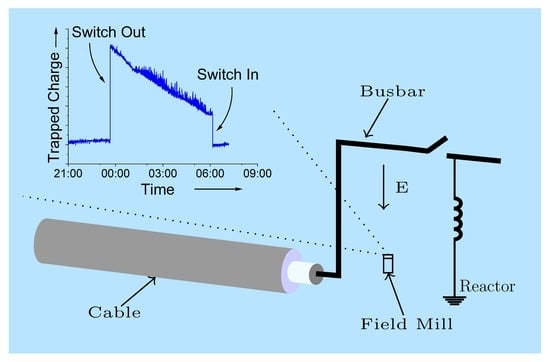Non-Contact Measurement and Analysis of Trapped Charge Decay Rates for Cable Line Switching Transients
Abstract
:1. Introduction
2. Background
Previous Work
3. Experimental Methodology
3.1. Test Conditions
3.2. Theoretical Considerations
3.2.1. Electric Field from Busbar Arrangement
3.2.2. Circuit Model of a Discharging Cable
3.3. Design of the Field Mill Site Setup
3.4. Laboratory Verification
4. Substation/On Site Results
5. Analysis of Field Measurement Data
5.1. Adopted Approach for Curve Fitting and Deriving an Instantaneous Time Constant
- The raw field mill data is fitted to a high order polynomial function to eliminate noise while preserving the underlying characteristic of the curve.
- A moving exponential fit, with window size W samples, is performed on the fitted waveform. For an N sample waveform, possible fits exist.
- The characteristics of the exponential fit, i.e., The RC time constant and are extracted for each position of the moving window. This is performed on a sample by sample basis, meaning for an N sample signal, possible fits will be produced.
- The instantaneous time constant, defined as the RC time constant computed for the previous W samples, can be plotted against RH, AH, time etc.
5.2. Relationship between Instantaneous Time Constant, RH, AH and Time
6. Conclusions
Author Contributions
Funding
Conflicts of Interest
References
- Boggs, S.A.; Chu, F.Y.; Fujimoto, N.; Krenicky, A.; Plessl, A.; Schlicht, D. Disconnect Switch Induced Transients and Trapped Charge in Gas-Insulated Substations. IEEE Trans. Power Appar. Syst. 1982, PAS-101, 3593–3602. [Google Scholar] [CrossRef]
- Pordanjani, I.R.; Wang, Y.; Cui, R.; Amiri, E. Discharge characteristics of trapped charge in power lines with underground cable and overhead line segments. In Proceedings of the 2016 IEEE/IAS 52nd Industrial and Commercial Power Systems Technical Conference (I CPS), Detroit, MI, USA, 1–5 May 2016; pp. 1–6. [Google Scholar] [CrossRef]
- Das, J. Transients in Electrical Systems: Analysis, Recognition, and Mitigation; McGraw-Hill Professional: New York, NY, USA, 2010. [Google Scholar] [CrossRef]
- Ghassemi, F. Effect of trapped charges on cable SVL failure. Electr. Power Syst. Res. 2014, 115, 18–25. [Google Scholar] [CrossRef]
- Secker, P. The design of simple instruments for measurement of charge on insulating surfaces. J. Electrostat. 1975, 1, 27–36. [Google Scholar] [CrossRef]
- Chubb, J.N. Two new designs of ‘field mill’ type fieldmeters not requiring earthing of rotating chopper. IEEE Trans. Ind. Appl. 1990, 26, 1178–1181. [Google Scholar] [CrossRef]
- Da Silva, F.F.; Bak, C.L.; Holst, P.B. Estimation of the Required Modeling Depth for the Simulation of Cable Switching in a Cable-Based Network. IEEE Trans. Power Deliv. 2012, 27, 1902–1908. [Google Scholar] [CrossRef]
- Da Silva, F.F.; Bak, C.L.; Holst, P.B. Switching Restrikes in HVAC Cable Lines and Hybrid HVAC Cable/OHL Lines. In Proceedings of the 2011 International Conference on Power System Transients (IPST), Delft, The Netherlands, 14–17 June 2011. [Google Scholar]
- Castellon, J.; Notingher, P.; Agnel, S.; Toureille, A.; Brame, F.; Mirebeau, P.; Matallana, J. Electric field and space charge measurements in thick power cable isulation. IEEE Electr. Insul. Mag. 2009, 25, 30–42. [Google Scholar] [CrossRef]
- Ghassemi, F.; Dennis, S.; Ainsley, A.; Haddad, A.M.; Robson, S. 275 kV cable discharge field measurement and analysis of SVLs chain failure using ATP. Electr. Power Syst. Res. 2018, 161, 95–102. [Google Scholar] [CrossRef]
- Lafaia, I.; Ghassemi, F.; Ametani, A.; Mahseredjian, J.; Dennis, S.; Haddad, A.M.; Robson, S. Experimental and Theoretical Analysis of Cable Discharge. IEEE Trans. Power Deliv. 2017, 32, 2022–2030. [Google Scholar] [CrossRef]
- Meyer, L.H.; Oliboni, C.R.P.; Graziano, G.C.; Mustafa, T.I.A.H.; Almaguer, H.A.D.; Molina, F.H.; Cassel, G. A study of the correlation of leakage current, humidity and temperature of 25 kV insulators in urban and rural areas. In Proceedings of the 2011 Annual Report Conference on Electrical Insulation and Dielectric Phenomena, Cancun, Mexico, 16–19 October 2011; pp. 398–402. [Google Scholar] [CrossRef]
- Wang, J.; Xi, Y.; Fang, C.; Cai, L.; Wang, J.; Fan, Y. Leakage Current Response Mechanism of Insulator String With Ambient Humidity on Days Without Rain. IEEE Access 2019, 7, 55229–55236. [Google Scholar] [CrossRef]
- Fontana, E.; Oliveira, S.C.; Cavalcanti, F.J.M.M.; Lima, R.B.; Martins-Filho, J.F.; Meneses-Pacheco, E. Novel sensor system for leakage current detection on insulator strings of overhead transmission lines. IEEE Trans. Power Deliv. 2006, 21, 2064–2070. [Google Scholar] [CrossRef]
- Suwarno, S.; Parhusip, J. Effects of Humidity and Fog Conductivity on the Leakage Current Waveforms of Ceramics for Outdoor Insulators. WSEAS Trans. Syst. 2010, 9, 442–452. [Google Scholar]
- Werneck, M.M.; dos Santos, D.M.; de Carvalho, C.C.; de Nazaré, F.V.B.; da Silva Barros Allil, R.C. Detection and Monitoring of Leakage Currents in Power Transmission Insulators. IEEE Sens. J. 2015, 15, 1338–1346. [Google Scholar] [CrossRef]
- WMO. Guide to Instruments and Methods of Observation; World Meteorological Organization: Geneva, Switzerland, 2008. [Google Scholar]
- Zhen, Y.; Cui, X.; Lu, T.; Wang, X.; Wang, D.; Liu, Y.; Ma, W.; Xiang, Y. A Laboratory Study on the Ion-Flow Field Model of the DC Wires in Stable Wind. IEEE Trans. Power Deliv. 2015, 30, 2346–2352. [Google Scholar] [CrossRef]
- Cui, Y.; Yuan, H.; Song, X.; Zhao, L.; Liu, Y.; Lin, L. Model, Design, and Testing of Field Mill Sensors for Measuring Electric Fields Under High-Voltage Direct-Current Power Lines. IEEE Trans. Ind. Electron. 2018, 65, 608–615. [Google Scholar] [CrossRef]
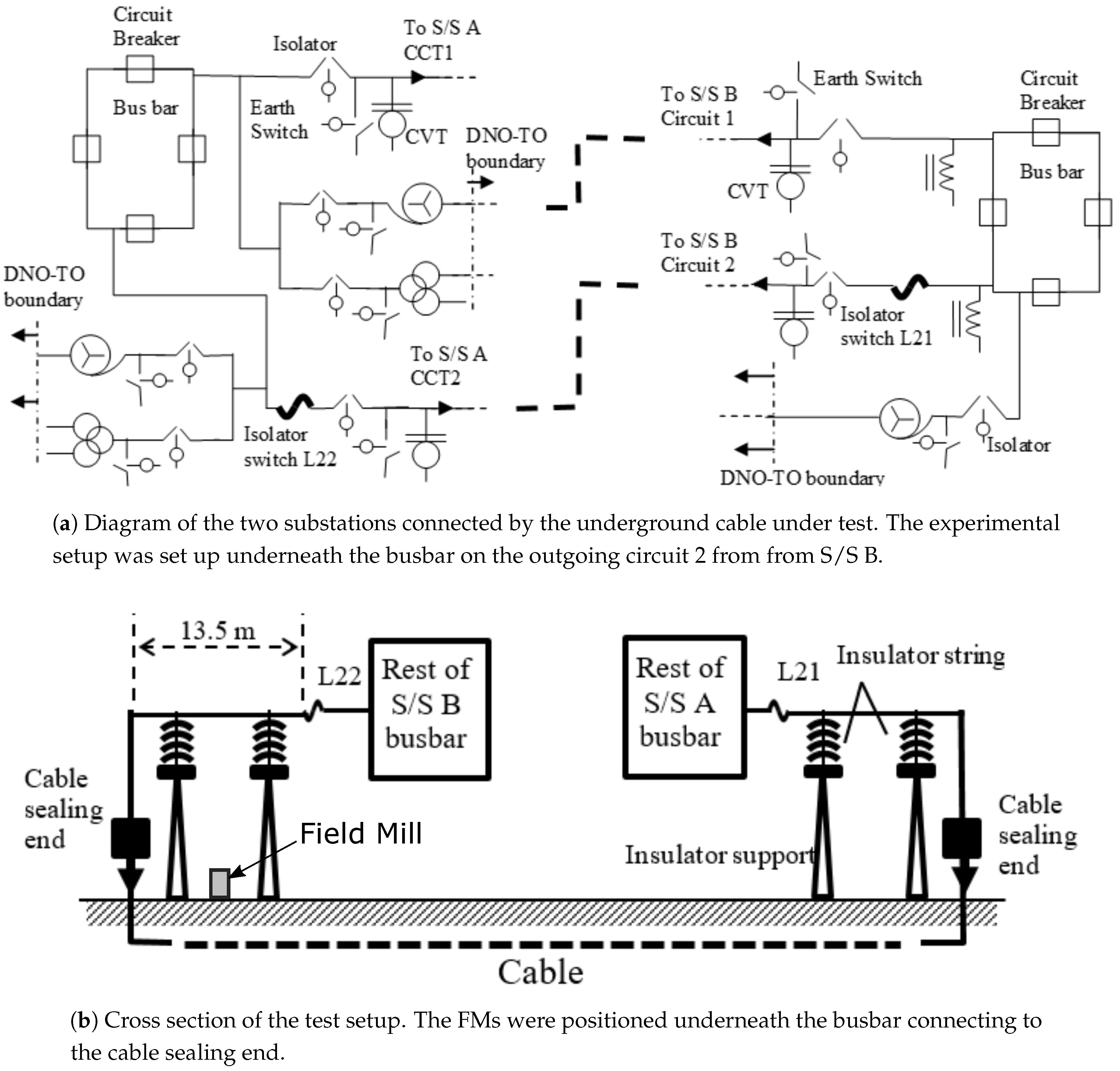
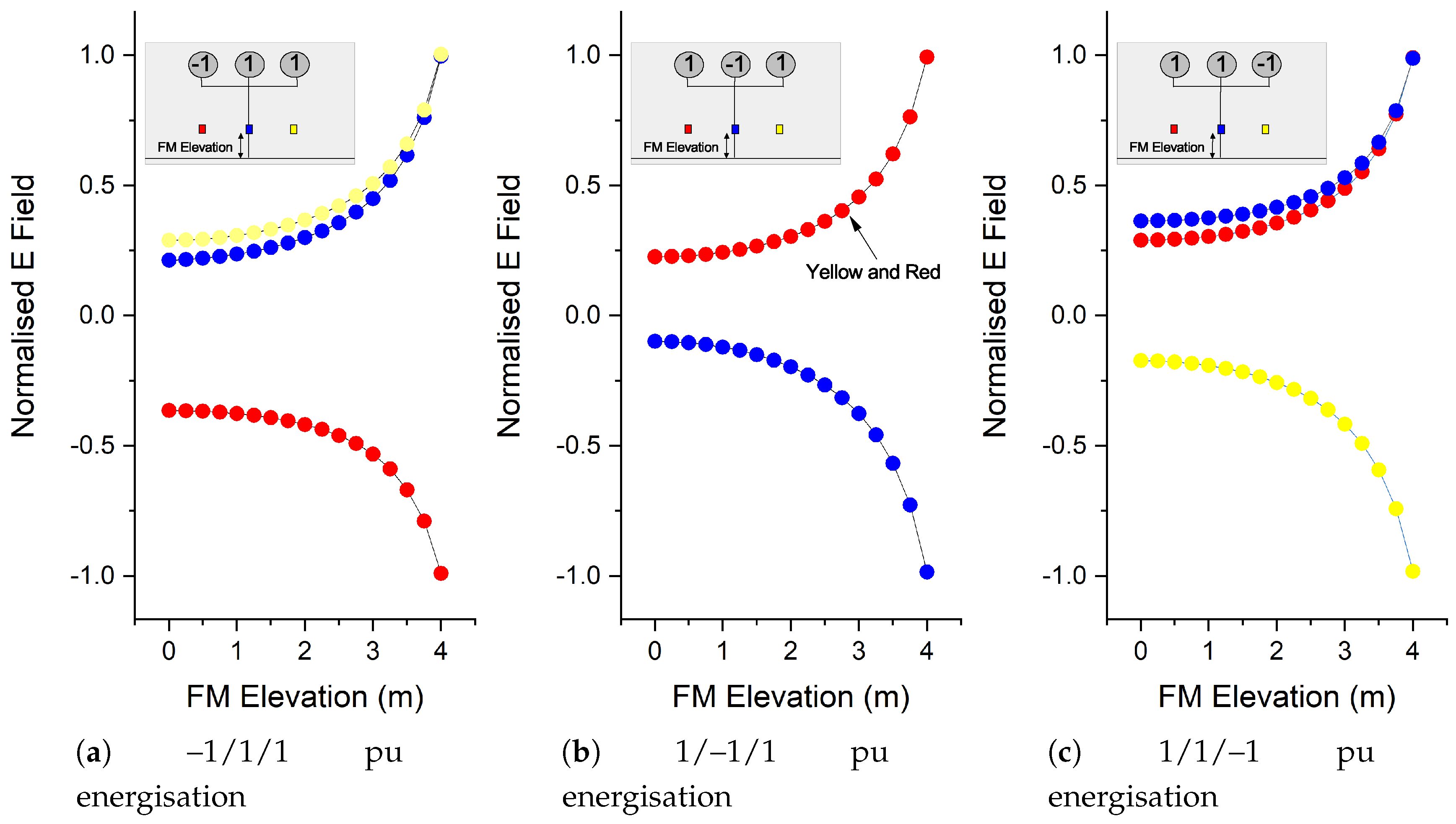
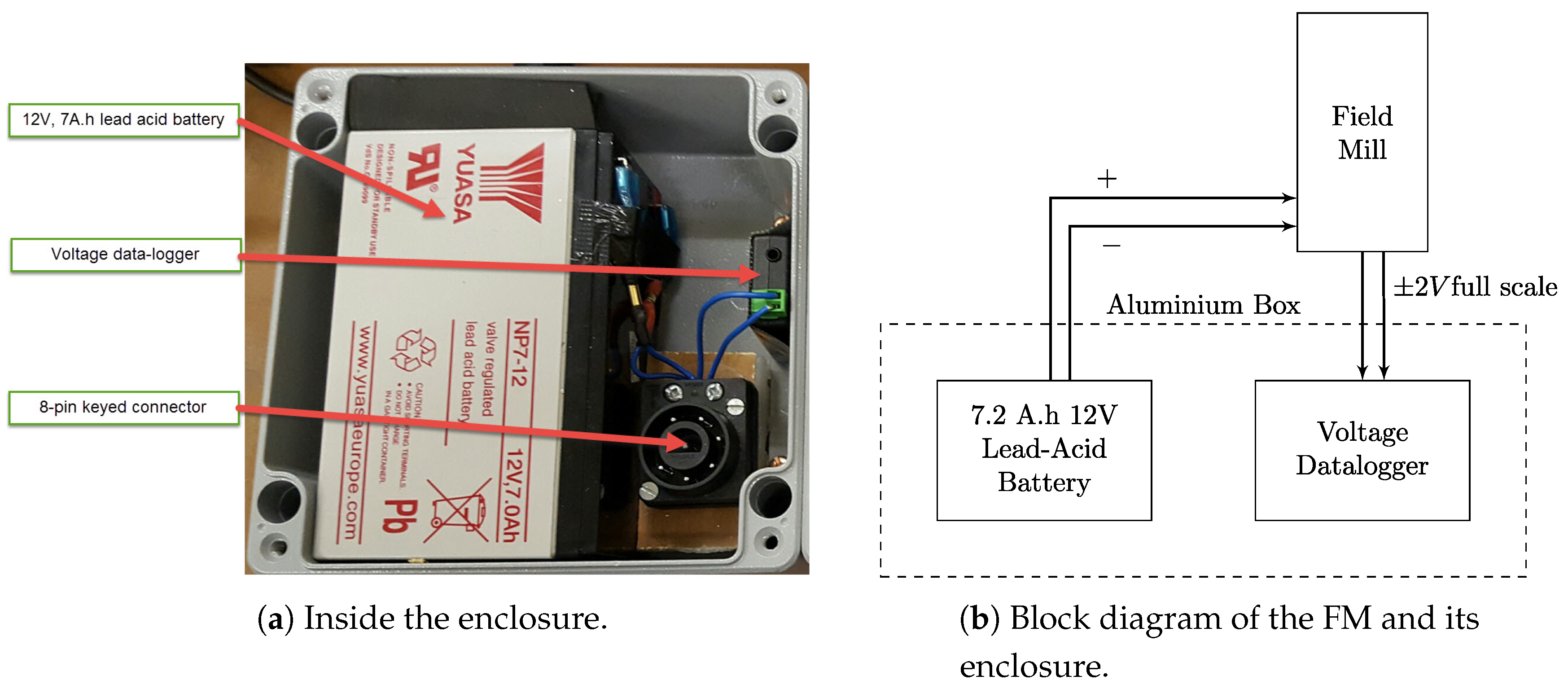

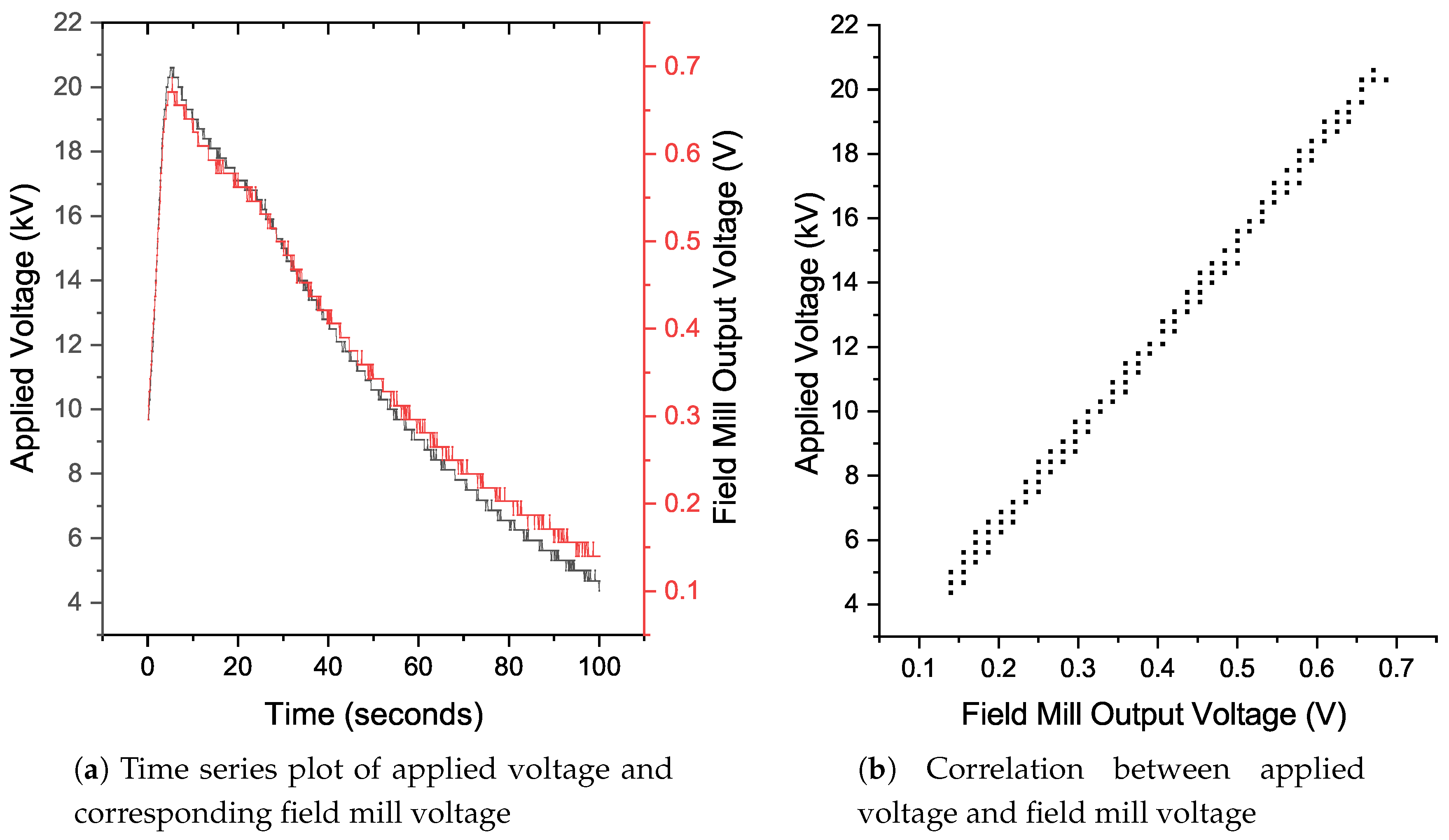
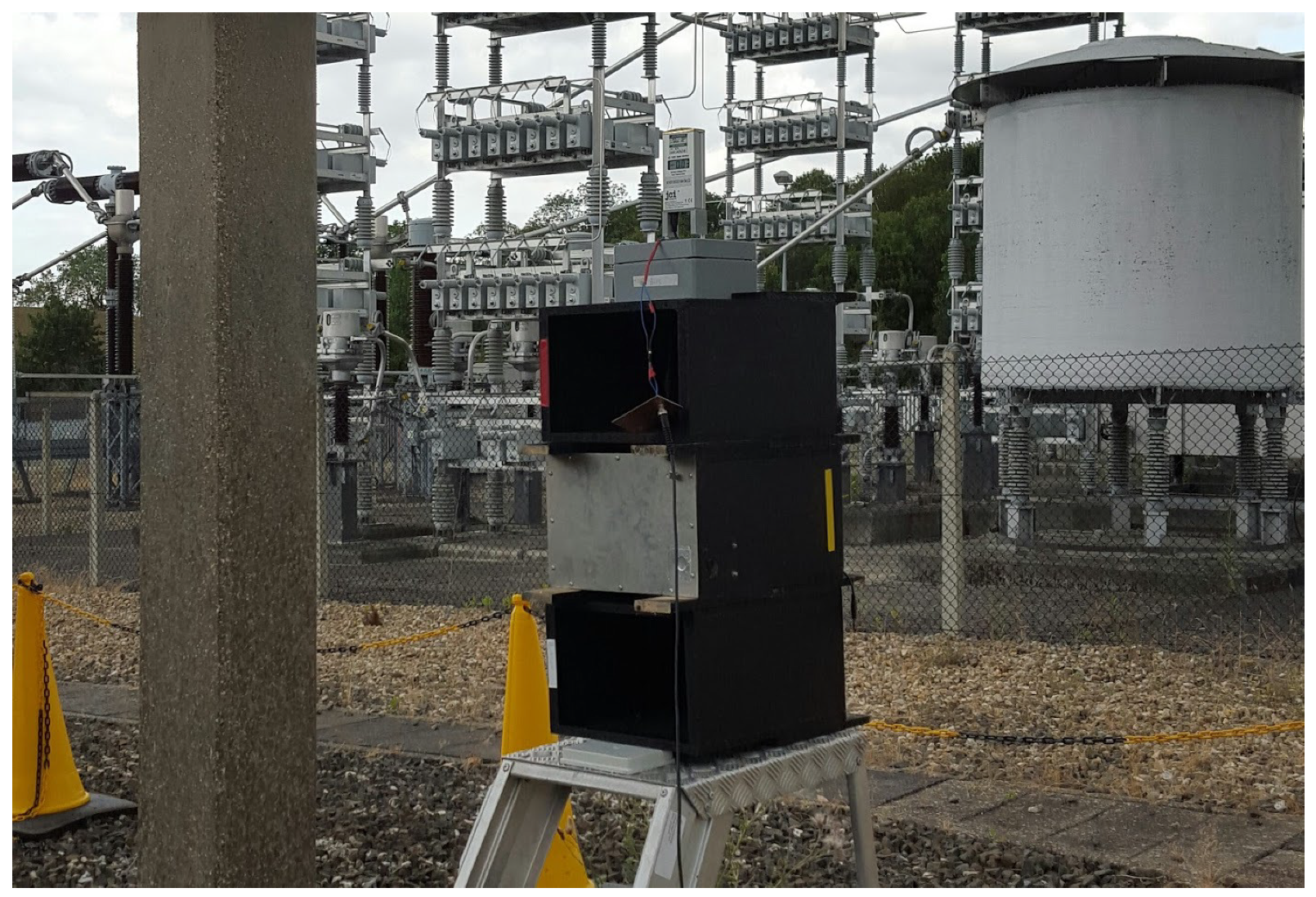
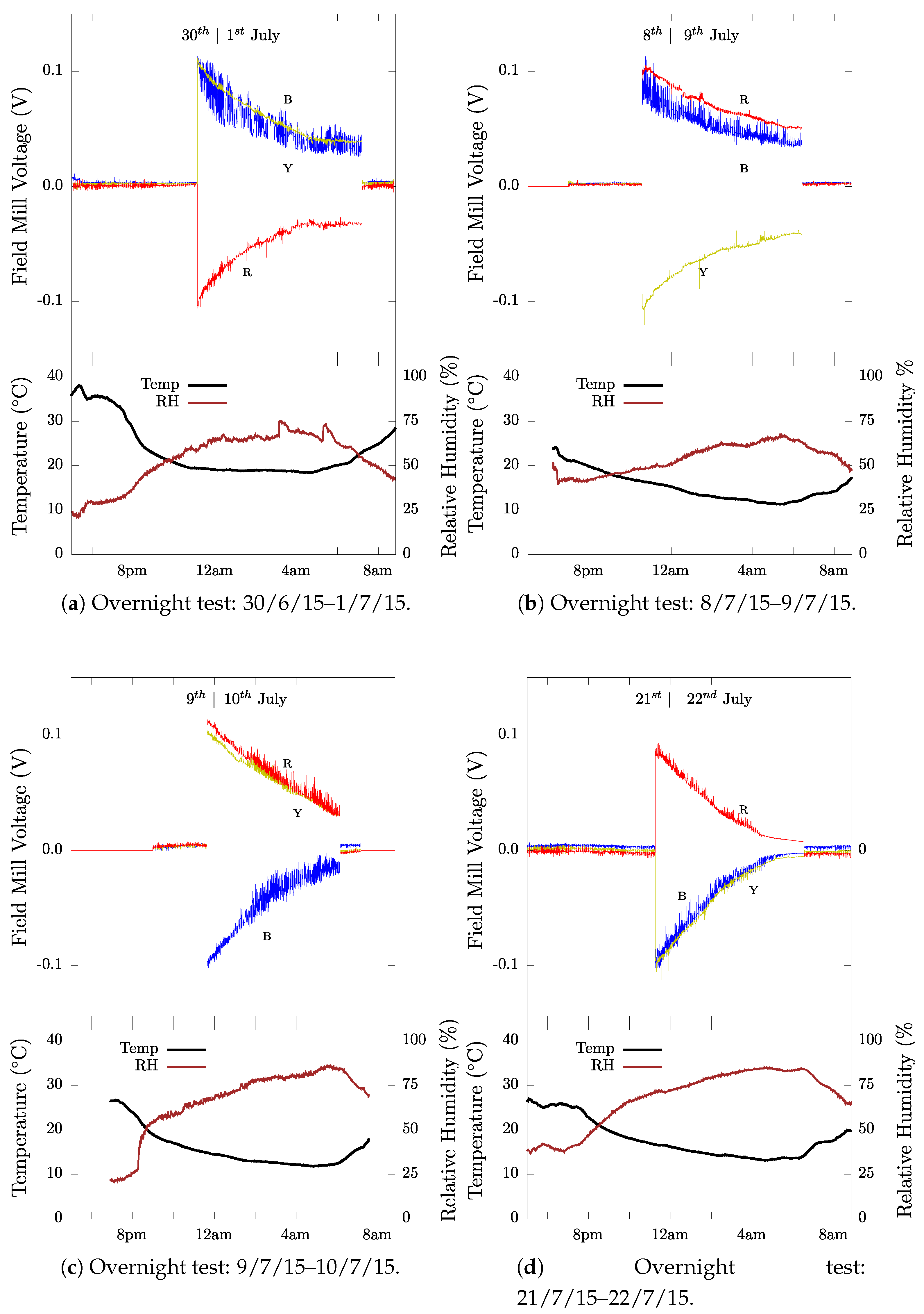
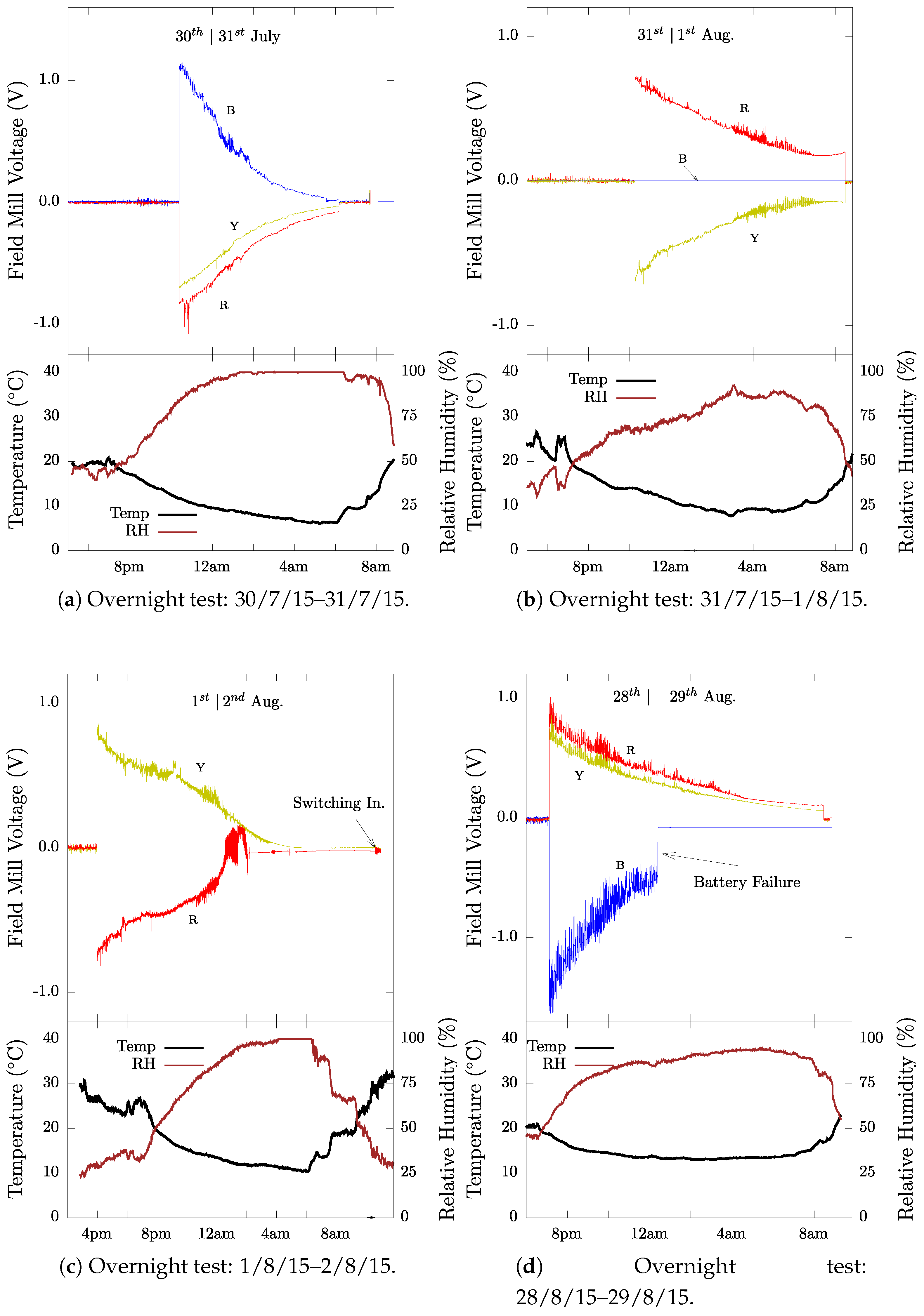

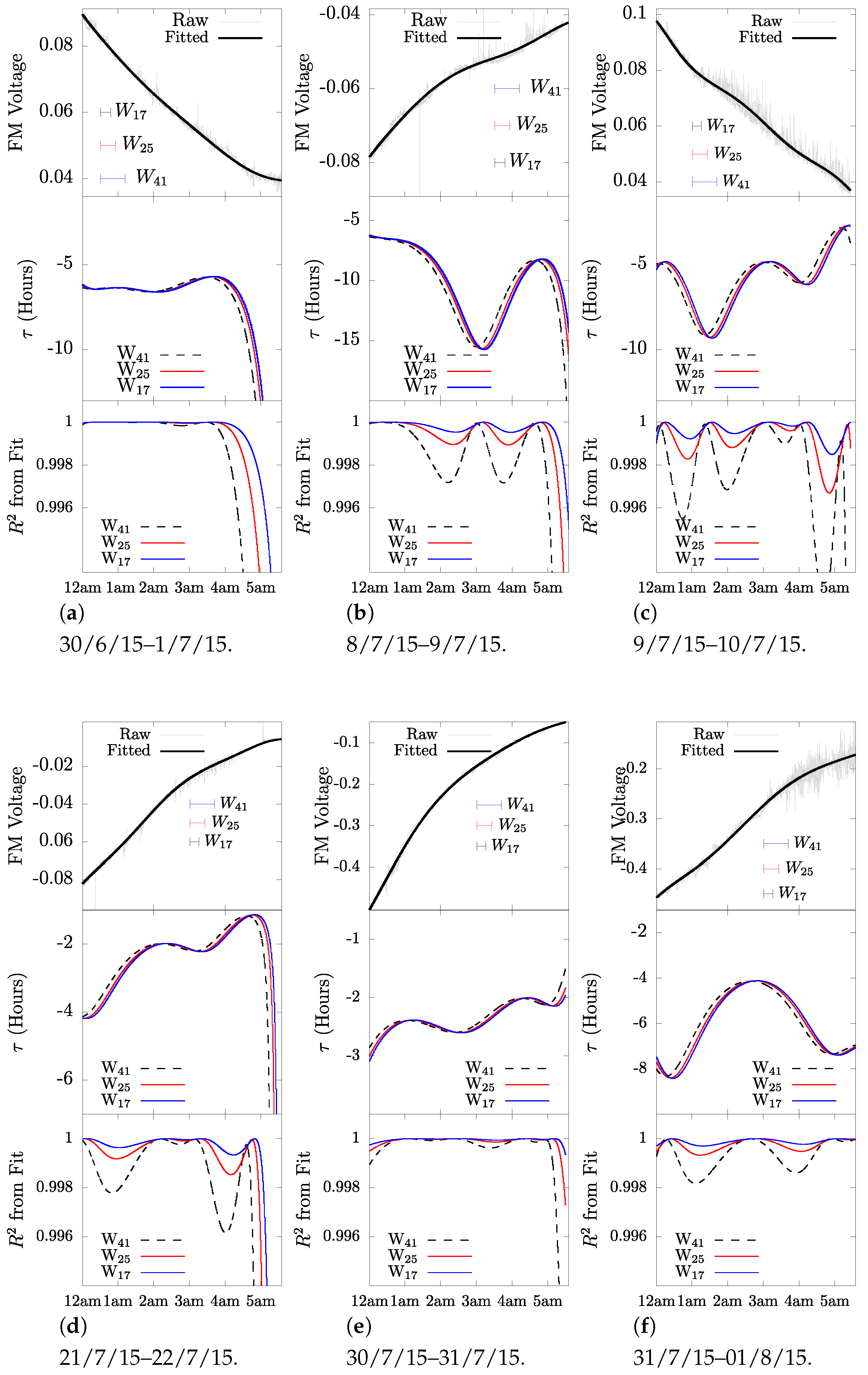

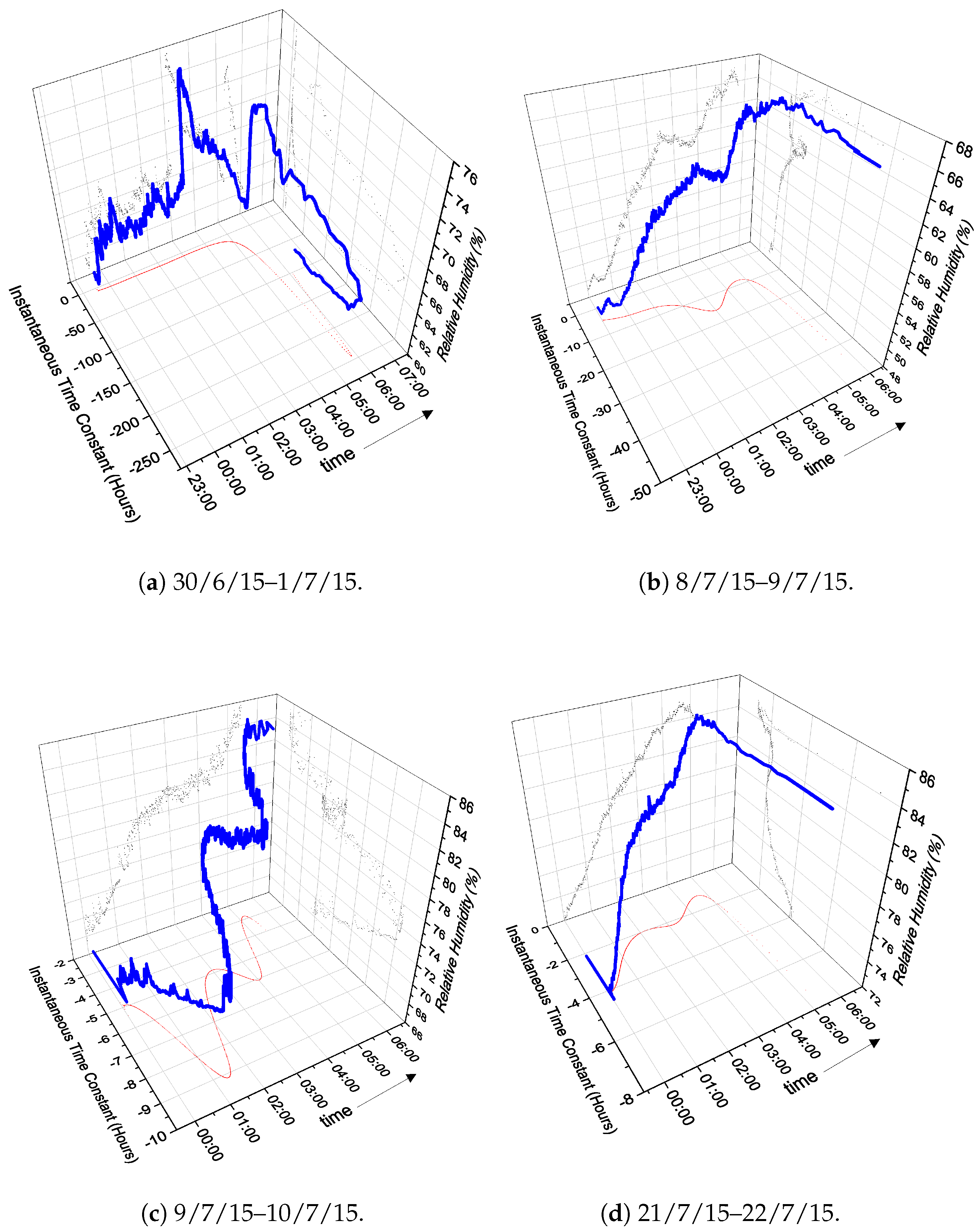
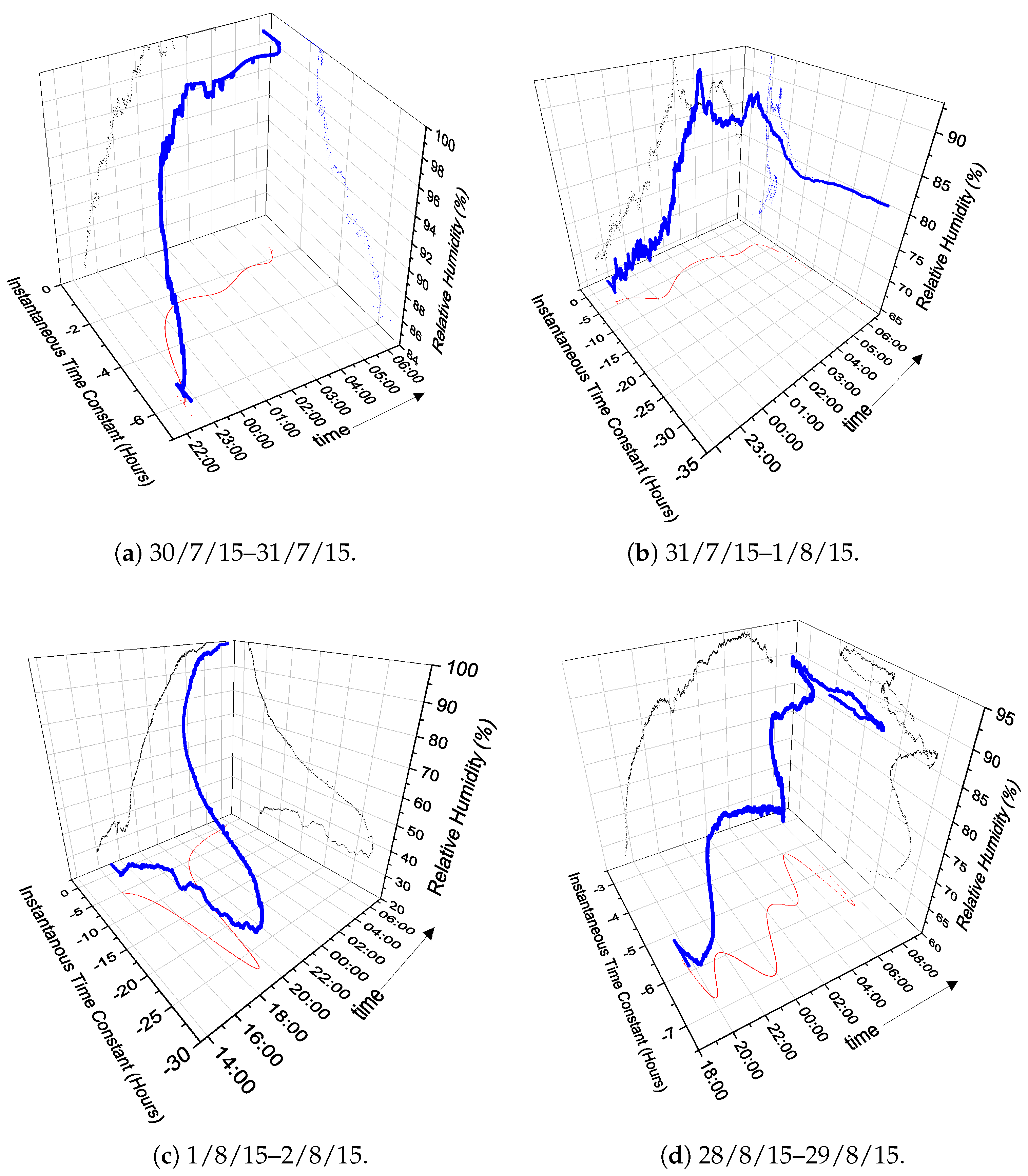
| Test Dates | (hours) | |
|---|---|---|
| (14/05/15)–(15/05/15) | 7.31 | 0.920 |
| (30/06/15)–(31/06/15) | 5.83 | 0.988 |
| (08/07/15)–(09/07/15) | 10.19 | 0.933 |
| (09/07/15)–(10/07/15) | 5.70 | 0.982 |
| (21/07/15)–(22/07/15) | 3.07 | 0.982 |
| (30/07/15)–(31/07/15) | 2.44 | 0.983 |
| (31/07/15)–(01/08/15) | 6.65 | 0.990 |
| (01/08/15)–(02/08/15) | 6.53 | 0.774 |
| (28/08/15)–(29/08/15) | 10.19 | 0.982 |
© 2020 by the authors. Licensee MDPI, Basel, Switzerland. This article is an open access article distributed under the terms and conditions of the Creative Commons Attribution (CC BY) license (http://creativecommons.org/licenses/by/4.0/).
Share and Cite
Robson, S.; Haddad, A.; Dennis, S.; Ghassemi, F. Non-Contact Measurement and Analysis of Trapped Charge Decay Rates for Cable Line Switching Transients. Energies 2020, 13, 1142. https://doi.org/10.3390/en13051142
Robson S, Haddad A, Dennis S, Ghassemi F. Non-Contact Measurement and Analysis of Trapped Charge Decay Rates for Cable Line Switching Transients. Energies. 2020; 13(5):1142. https://doi.org/10.3390/en13051142
Chicago/Turabian StyleRobson, Stephen, Abderrahmane Haddad, Simon Dennis, and Foroozan Ghassemi. 2020. "Non-Contact Measurement and Analysis of Trapped Charge Decay Rates for Cable Line Switching Transients" Energies 13, no. 5: 1142. https://doi.org/10.3390/en13051142
APA StyleRobson, S., Haddad, A., Dennis, S., & Ghassemi, F. (2020). Non-Contact Measurement and Analysis of Trapped Charge Decay Rates for Cable Line Switching Transients. Energies, 13(5), 1142. https://doi.org/10.3390/en13051142





